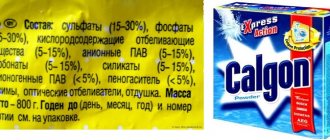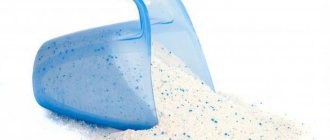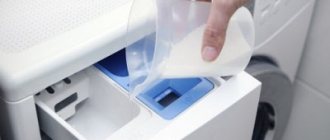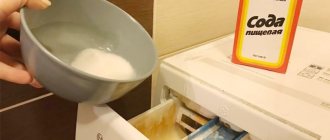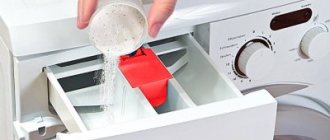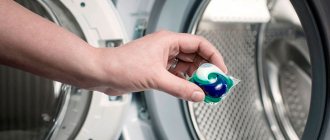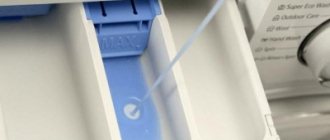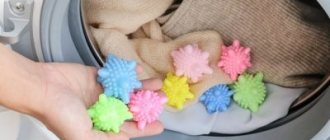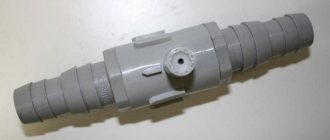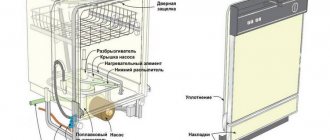Many have often heard the phrase - why pay more when choosing washing powder, because they are all the same. This is not entirely true - some manufacturers may use high-quality synthetic materials, others - cheaper ones. It is worth understanding the composition of washing powders and their varieties in order to choose the best detergent.
Composition and principle of action
Most dry powders are quite aggressive due to their composition.
Let's list the main components thanks to which dirty clothes become clean and fragrant:
- Anionic surfactants (surfactants), foaming agents, are the main detergent component of washing powder. Their share can range from 5 to 15%. The more there are, the more aggressive the product. They are cheap to produce and effective. They wash various stains, grease and dirt well, reacting with them on the surface of the fabric. But the danger is that these components are poorly rinsed out of the fibers and penetrate the human body, causing various diseases. In a number of European countries they are recognized as toxic; their content in the product should not exceed 2%. They are also not recommended for hand washing, as they dry out the skin and cause dermatitis.
- Nonionic surfactants, unlike the former, are not toxic. They act deep in the fabric, rinse well, and then disintegrate in water into safe components. Works well in cool water. The disadvantage is that they form little foam, which is why they can only be used together with anionic surfactants.
- Cationic surfactants have disinfectant and weak cleaning properties. Used to neutralize the harmful effects of anionic surfactants in expensive detergents.
- Phosphates or phosphonates (a less dangerous form) soften water during washing and enhance the effect of surfactants. They pose a great danger to the environment, and also contribute to the fixation of powder particles on the fabric. In a number of Western European countries, they are completely abandoned, replacing them with zeolites, which reduces the toxicity of detergents.
- Brighteners (optical, oxygen) make laundry white, remove grayish or yellowish tints, and disinfect.
- Enzymes are components that destroy organic stains that surfactants cannot cope with. They are effective in water up to 40°C; at temperatures above this they lose their properties, as they have a protein base. Expensive powders contain several types of enzymes, for each type of contamination. There is only one in budgetary funds.
- Fragrances that do not remove unpleasant odors, but only mask them. Expensive powders contain natural aromatic substances, while budget ones contain synthetic ones. A strong fragrance can trigger allergies and simply be intrusive, so this is also worth paying attention to.
Dry
To prepare dry powders, dry laundry soap, grated on a fine grater, is used. All necessary components are mixed, at the last stage a few drops of essential oils are added, mixed and placed in an airtight container.
Recipe 1:
- 150 g dark laundry soap;
- 500 g regular soda;
- 400 g soda ash;
- essential oil.
Whitening Powder Recipe:
- 1.5 cups of laundry soap;
- 1 cup soda ash;
- 0.5 cups baking soda;
- 1 cup borax;
- a few drops of aromatic oils.
Recipe 3:
- 2 pieces of crushed laundry soap;
- 1 cup baking soda;
- 1 cup soda ash;
- 2 tablespoons of vinegar (3 or 9 -%);
- essential oils (essential to eliminate the strong smell of vinegar).
How to choose washing powder?
Here are some criteria for a good washing powder:
- Compound. If possible, choose products with an environmentally friendly composition, with a surfactant content of 2-7%. They should not contain chlorine, phosphates, sulfates. But biodegradable enzymes are welcome.
- Flavorings, preservatives and dyes can cause allergies. It is better to give preference to products with a light, unobtrusive aroma or no scent at all. If you can feel it even through the packaging, you should beware.
- Type of washing. Hand wash powder is not suitable for washing machines due to increased foaming.
- Type of washing powder depending on the type of fabric and its color. Some components of universal products are harmful to wool and silk, and white powder is unsuitable for multi-colored items.
Introduction.
The modern chemical industry makes our lives much easier. If you live in an urban environment, look in almost any direction and you will see some product of the chemical industry. In this article we will analyze such necessary and useful products as washing powder. Every day a person faces pollution that stains his clothes. Chemists have developed and introduced a huge number of chemical compounds that help deal with stains during washing.
By type of wash
Manual
To remove stains from laundry manually, it is best to choose a universal or specialized powder for manual washing. It produces more foam than detergent for an automatic washing machine, so it is much easier to get rid of dirt yourself.
“Hand Wash Gloss” is well suited for this. Its advantages:
- Hypoallergenic.
- Effectively removes stains even in cold water.
- Good solubility.
- Protecting fabric from damage.
However, Losk is not suitable for washing delicate materials. It also dries out the skin of your hands, so it is better to use gloves.
The brands “Ariel”, “Persil”, “Pemos” have also proven themselves well.
Machine
For washing in an automatic machine, you can use any products marked “automatic” or “universal”.
Persil Expert is considered one of the best. It is suitable for both white and colored linen. It contains a stain remover, which increases the cleaning efficiency. In addition, Persil does not cause allergies.
However, to keep the laundry soft, it is recommended to additionally use conditioner.
Links
- Derbyshire, David
.
[www.dailymail.co.uk/news/article-518457/Dont-bother-pre-wash-youre-just-wasting-6billion-litres-water-year.html Don't bother with pre-wash (you're just wasting 6billion liters of water a year)], Mail Online
(24 February 2008). Retrieved September 30, 2010. - [housewares.about.com/od/laundryappliances/f/hedetergents.htm]
- [www.chemistry.co.nz/deterginfo.htm Campbell tips] for detergents chemistry, [www.chemistry.co.nz/surfactants.htm surfactants], and [www.chemistry.co.nz/deterghistory.htm history] related to washing laundry, [www.chemistry.co.nz/stain_frame.htm destaining methods] and [www.chemistry.co.nz/soil_id.htm soil].
- [www.laundryworks.ca//soap.com]
By release form
Dry
Dry products have several advantages:
- All washing machines are designed specifically for this form of release.
- They are cheaper than washing gels.
But they have more disadvantages:
- They don't rinse well and leave marks on dark clothes.
- They have a more aggressive composition.
- The drain may become clogged, leading to leaks.
- Less effective than their gel counterparts.
Liquid
To the question “Which is better, powder or gel?” There is no definite answer, but lately liquid products have become more popular. They are more concentrated, effective, rinse better, and do not leave streaks on clothes. They can be added directly to the drum, which also affects the quality of the wash. In addition, they are suitable for down jackets and coats with fillers, membrane fabrics (specially marked products).
Capsules
Universal laundry capsules contain several active ingredients at once, which enhances their effectiveness. However, this also increases the cost. The active substances in universal capsules are very concentrated, so they are not suitable for hand washing and baby clothes. Children's clothes should be washed only with special detergents.
Plates
The plates are the latest achievement of scientists who develop the most effective formulas and types of household chemicals. Leaf products are hypoallergenic, safe, economical, versatile, and have antibacterial properties. However, their cost is higher than that of gels or capsules.
By purpose
For white laundry
Powders for white laundry differ from others in that they contain bleaching components (chlorine, optical, oxygen). You should choose products with oxygen or optical bleach, as they are the most harmless and are suitable for any fabric.
Nordland
An excellent powder product of the latest generation with an environmentally friendly composition. Instead of phosphates, it uses zeolites - natural components, as well as a small amount of anionic and nonionic surfactants, optical brightener and soap. The powder is completely rinsable, safe for the environment, and labeled “ECO.”
Advantages:
- Suitable for all types of fabrics.
- Does not cause allergies.
- Suitable for children's underwear.
- Economically used.
Disadvantages: the high price of Nordland powder and the danger of purchasing a fake.
Persil Premium
Excellent for removing organic and vegetable stains: fat, juice, blood, jam. Suitable for any washing, both manual and automatic. The composition contains optical brighteners, which give the laundry a brilliant whiteness even at low washing temperatures.
For colored laundry
Washing powder for colored clothes adds brightness, freshness, and removes stains without losing color.
Top house color ultra
You can find Top house only on the shelves of specialized household chemical stores and on websites. Another disadvantage is that it is not suitable for washing silk and wool.
Here are its advantages:
- Economical.
- The ability to remove very difficult old stains thanks to enzymes.
- Action at low temperatures (30-60°C).
- Convenient handle available.
- Contains components that prevent scale formation.
Persil Color
- There are no aggressive substances in the composition.
- Active stain removers remove even old stains.
- Effective in cool water.
- Versatility: for all types of fabric.
The disadvantage of Persil is that it is wasteful.
Burti Color
This German-made powder is effective and removes any stains well. The list of its advantages also includes: safety, hypoallergenic, environmentally friendly, easy to use. In addition, it is excellent for hand and machine washing of colored and delicate items.
However, it is quite difficult to find Burti Color in a regular hypermarket; it is usually sold in specialized stores. The price will not please you either - it is higher than that of more common analogues.
For black
For powders of this purpose, it is important that they are washed out well, without the formation of streaks. However, not all brands produce such products.
Weasel Magic of Color
This gel, despite the high price, is popular. It helps maintain the original color and does not leave stains or marks. In addition, it prevents clothing from shedding, rinses well, and leaves a pleasant smell.
Synergetic for black
This is another liquid gel that helps to gently and effectively remove stains from clothes without leaving streaks on it. The advantage of Synergetic is that it contains natural ingredients that repel dirt.
This gel can be used for both hand and machine washing.
For children's things
Eared nanny
Domestic hypoallergenic washing powder has several advantages:
- Low cost compared to foreign analogues.
- Versatility.
- Sold in packages from 0.4 to 8 kg.
- Removes stains of various origins.
However, “Eared Nanny” contains phosphates and a large number of aggressive surfactants, which adversely affect the baby’s health.
Baby Care Sensitive
This laundry detergent for washing baby clothes is great for newborns, as it has an environmentally friendly composition. Pros:
- Lack of chlorine, phosphates.
- Efficiency.
- Giving light laundry whiteness and preserving color.
- Hypoallergenic.
- Convenient packaging.
- Low cost for washing.
The only downside of Baby Care is poor rinsing.
History of creation
The first washing powder was created by German chemist Fritz Henkel. Its basis at that time was sodium silicate. In 1876, Fritz organized the Henkel company, which began releasing a new product called “bleaching soda” to the masses. It quickly became popular because it washed things well and was inexpensive.
The first soap powder appeared on the market a year later. Its creators founded the company Thompsons Seifenpulver GmbH. At the same time, the Henkel factory developed.
In June 1907, the first washing powder for cars (Persil) saw the light of day. This saved housewives from having to boil things to make them white.
In Russia, washing powder appeared only in 1953 , it was a product called “Novost”. It was produced in Kazan at a chemical plant. A new round of development occurred in 2000, as a result, a powder with a composition familiar to modern people entered the market.
By composition
Phosphate
Most washing powders contain phosphates or phosphonates - substances added to soften water and increase the effectiveness of surfactants.
However, such washing powders cause great harm:
- Cause allergies.
- Getting on the skin and in the respiratory tract, they cause diseases.
- The drains become clogged, which leads to damage to the washing machine.
- Harm the environment, especially water bodies.
To reduce the harmful effects of synthetic laundry detergents, follow these rules:
- Carry out hand washing only with gloves;
- do not soak clothes for a long time;
- rinse the laundry 5-8 times, set the washing machine to an additional rinse;
- use hot water from 50°C; in cold water, harmful substances do not dissolve and remain on the fabric;
- Reduce contact with powder, wash less often if possible.
If possible, give preference to environmentally friendly, phosphate-free products.
Phosphate-free
Over the past 15 years, phosphate-free powders have become increasingly popular. This is no coincidence, while maintaining the washing quality at the level of conventional powders, they have additional advantages:
- Hypoallergenic.
- Degradable cleaning ingredients.
- Taking care of your skin.
- Minimal harm to health.
Such products can be used to wash the clothes of children and people with dermatological problems.
The disadvantage is their higher price.
Biomio
Product made in Russia. This safe washing powder has the following properties:
- Concentrated, which reduces consumption.
- Softens laundry.
- Has a neutral odor.
- Versatile.
- Takes care of the skin.
However, BioMio can only remove simple, fresh stains.
Klar Eco Sensitive
The product of the German manufacturer, in addition to the absence of phosphates, does not contain chlorine, sulfates, or parabens. This high-quality mineral and plant-based laundry detergent is great for allergy and asthma sufferers. It is easy to rinse, odorless, environmentally friendly, and versatile.
Storage conditions
The composition can be stored both in the original packaging and in other suitable containers. The main thing is that the container is tightly closed . Do not allow moisture or debris to get inside.
The room chosen is dry, dark and cool. Children should not have access to detergent. It is important to monitor the expiration date of the composition and not use expired products. Read about expiration dates for washing powders here.
Where do you put the powder in the washing machine?
The location of the powder compartment depends on the type of washing machine; there are two of them:
- With vertical loading (the door is on top, laundry is loaded vertically).
- Front loading (the machine opens from the side).
If the machine has a vertical loading type, the trays are located on the inside of the top door, in the middle.
If the washing machine has a front loading, the compartments can be found in the left or right corner, they will slide out.
However, once the compartments are found, another problem arises: figuring out which one to use.
In total, in any type of automatic machine there are three compartments, which are usually marked with icons:
- Compartment for pre-soaking. On it you can find the letter A or the number I.
- Tray for the main active ingredient: powder or gel. It is usually the largest and is marked B or II. Washing powder must be poured here. Sometimes this compartment is divided into two parts, and some models come with a plastic dispenser that is installed in the tray, allowing you to use the product more economically.
- The rinse aid compartment is the smallest, often has a different color from other compartments, and is marked with the signs C, III, an asterisk or a flower.
- Sometimes powder is added to the drum, but this is a last resort and should only be used if the tray is seriously damaged. It leaves stains on the fabric, especially dark and colored ones, which cannot always be washed off. Therefore, you should not add the product directly to clothing. If you pour the powder onto the walls of the drum, most of it will immediately be washed away by the water that remains after previous washes. The same thing will happen with pre-soaking. Also, with this method, it will be impossible to use the air conditioner and some functions of the automatic machine, which provide for portioned addition of the product.
If it is not possible to use the compartment, you should place the powder in a plastic jar with holes in the lid, so that the product will gradually enter the drum during the washing process.
Gels, capsules, coarse-grained, soap-based, phosphate-free products, on the contrary, must be placed in the drum.
How much powder should I pour?
The amount of detergent depends on several factors:
- Volume of loaded laundry.
- The degree of contamination of clothing - the higher it is, the more bulk substance is required.
- Hardness of water. If there is a residue on the walls of the dish after boiling, the water is hard.
- This can be compensated for with softeners.
- Selected type of washing (hand or machine).
- Selected mode.
Some newer models have a function that automatically determines the amount of powder needed for washing.
Typically, the manufacturer indicates the proportions of the detergent on the packaging, but in practice you can adhere to the following recommendations:
- 1 tbsp. l. (20-25 g) per 1 kg of laundry, if it is slightly soiled;
- 1.5-2 tbsp. l. in the presence of stubborn stains and increased water hardness.
Information given by the manufacturer
World-class manufacturers who value their reputation, as a rule, provide complete detailed information on the composition.
They also indicate:
- Your contact information.
- Storage requirements.
- Order of use.
- Purpose.
- Best before date.
- Date of manufacture.
An example of comparative characteristics of the compositions of some popular washing products is presented in the table:
You can trust the information on the packaging of products from well-known manufacturers who value their reputation. The inspection is carried out by regulatory state bodies of the Russian Federation .
